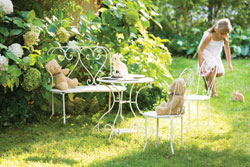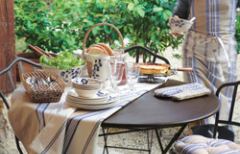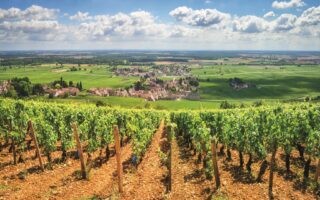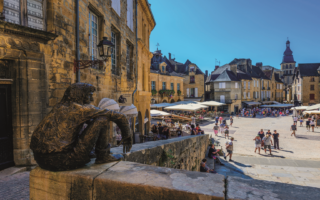In Praise of the Sunny South

Those who have been lucky enough to spend a summer in Provence know that it is an exceptional experience – the combination of scent, sound and heat make it unlike anywhere else. Sit on your covered terrace or in the shade of a tree in the afternoon and you will see the occasional insect fly by, but not a bird stirs, not a dog barks. In the evenings the cigales add their mesmerising, hypnotic chant to the peace.
No wonder outside spaces are so important in that beautiful south east part of France. In Provence, from April/May to September/October, life happens outside: breakfast, lunch, supper, children playing or doing homework, snoozing pets, drying the laundry, cooking, chatting, singing, reading a good book, talking to the neighbours, listening to the radio, even watching television.
When speaking of Provence, the term ‘garden’ is, generally speaking, only used in the loosest sense of the word. Because of the drought it’s a huge waste of precious water to have gardens the way we have them here. Months go by without a drop of rain, which, combined with the tremendous heat, shrivels up all but the most drought-resistant grass, plants and trees.
The Provençal garden, therefore, usually consists of an area covered in fine gravel, with large (often ancient) shade-giving trees, such as planes, which are very much part of village and townscapes in Provence. In the spring you can see pollen all around you, dancing in the breeze, covering cars, in drifts along the kerbs. Hay fever sufferers, beware! If there is room you will also usually find an area covered with coarse grass (the only kind that can survive here) dotted with fruit, nut and olive trees.
The Summer Kitchen
Because it is sheer hell to have to cook in an indoor room when the house is boiling hot from the heat of the day, many Provençal houses have a cuisine d’été (summer kitchen). Some are purpose-built structures with stone or rendered brick walls on three sides and a properly tiled roof.
They will usually be tucked in between some trees, safely in the shade. Others are simply under a lean-to roof attached to the house, garden wall or shed. They usually house a BBQ and pizza oven, a sink with running water, a space for a small fridge (which lives in the garage during the winter) and a gas hob of some sort.
On the gravelled area – the ‘terrace’ – besides pots of geraniums, you will find all the accoutrements of Provençal outdoor living, which bear little resemblance to the items you find in British gardens. No matching sets of a DIY store’s latest range of garden furniture, no colour-coordinated cushions and tablecloths, no brand-spanking new parasols or weather-resistant fabric gazebos.
Provence, apart from the coastal stretch, is not a wealthy region. The landscape is inhospitable, and especially in rural communities people literally scrape a living off the land. At the same time they are not too interested in whether things look ‘nice’ – what is important is that they are functional, affordable, and comfortable. So outside (and usually inside as well) you will find a big old kitchen table with an assortment of non-matching chairs.
 The joy of it hardly ever raining in the summer is that you can put your old upholstered chairs outside. One of the finest sights in Provence is an old (usually quite dilapidated) house, the shutters half-closed against the sweltering midday sun, and the family having their prolonged lunch outside, children and dogs playing, all in the shade of those ancient trees.
The joy of it hardly ever raining in the summer is that you can put your old upholstered chairs outside. One of the finest sights in Provence is an old (usually quite dilapidated) house, the shutters half-closed against the sweltering midday sun, and the family having their prolonged lunch outside, children and dogs playing, all in the shade of those ancient trees.
There is something so serene and perfect about it and – probably because of the lack of ‘nice’ furniture – it has a grandeur and class that is inimitable, enviable, unique. It certainly cannot be replicated by throwing money at it.
Similarly, when a Provençal family goes on a picnic (a regular occurrence at weekends), the exercise is in a class all its own. They invariably bring out at least four generations and a few dogs, and once these have been offloaded, next out is the assortment of folding chairs and tables.
After great-gran has been lowered into the best chair in the best position, whence she can oversee and guide the proceedings, out comes a seemingly never-ending stream of coolboxes, baskets and boxes, all crammed full with food, wine and water… and not a clingfilm-wrapped soggy sandwich amongst them!
Once all the food has been set out, it looks exactly as though it was just carried out from a kitchen two feet away. The tables are heaving, it’s real food, and usually consists of the regular three to four courses. It takes hours to eat it, from real plates with real napkins and with proper cutlery and wine glasses – followed by a snooze in the shade.
‘A summer in Provence’ has little to do with throwing money at your garden, or at your outings. It has to do with living in the moment, with enjoying the simple things, with taking time, and with being able to find peace in certain moments of your life.
By Mayke Hogestijn, founder and director of Lavender & Sage, an online retailer specialising in traditional French home accessories and furniture. For more information on Lavender & Sage, call 0845 601 0522
Share to: Facebook Twitter LinkedIn Email
More in children, cooking, courses, family, guides, summer, wine
Leave a reply
Your email address will not be published. Required fields are marked *



